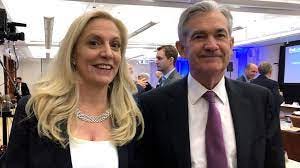The speculation is over. In a move to maintain “stability and independence” at the Fed, the White House today announced that President Biden will reappoint Fed Chair Jay Powell and nominate as Vice-Chair Fed Governor Lael Brainard. The announcement is expected to generate strong bipartisan support in Congress, leaving Biden with three more Fed Board slots to fill in the coming months, including the high profile role of Vice Chair, Supervision.
Mr. Powell initially joined the Fed Board as an Obama appointee in 2012. He became Fed chair in February 2018 after being nominated by President Trump to replace Obama-appointee Janet Yellen, now Treasury Secretary under President Biden, for a term expiring in February 2022. Prior to joining the Fed, Mr. Powell was an attorney and private equity executive and worked in several high level positions at the US Treasury under President George W. Bush. Powell is the first non-economist to serve as Fed chair since the appointment by President Truman in 1951 of William McChesney Martin, who had studied English and Latin at Yale. (Econ and math would have been a better choice, but then his boss President Truman was a haberdasher and failed farmer who did not attend college.)
Dr. Brainard was appointed by President Obama in June 2014 for a term expiring in January 2026. Dr. Brainard is an academic economist with a PhD from Harvard, who also worked for the US Treasury under President Obama and as an economic advisor to President Clinton. She is an expert in international finance, grew up in Germany before the fall of the Berlin Wall, and worked at McKinsey before joining the Treasury.
Mr. Powell’s four years as Fed chair were eventful, to put it mildly. Less than a year after taking office, the covid pandemic struck in China and then quickly spread throughout the world, triggering the worst economic crisis since the events of 2008+ or arguably since the 1930s. The Fed worked with the US Treasury and their international counterparts to implement a massive and unprecedented monetary and fiscal policy response, credited by many with preventing a catastrophic collapse of the US and global economy but leaving many challenges still to be addressed.
The Fed’s challenges are not over, not by a long shot. Mr. Powell and the Fed Board need to deal with a growing inflation threat while not derailing the strong recovery of the US economy and the labor market in particular. Any monetary policy moves they make, including the rollback of QE as well as possible future changes to the Fed’s short-term interest rate targets, need to be coordinated with the large new fiscal policy initiatives of the Biden administration. And this all needs to be done at a time when the economics profession (and presumably the Fed) is debating and revising some of its previous understanding of how fiscal and monetary policy interact, particularly at a time of historically low interest rates and already high fiscal deficits and debt. (On this last point, see the links below regarding Modern Monetary Theory.)
The Fed also has a number of other challenges ahead of it, including the development of alternative payments systems which could have a profound impact on the banking industry as it operates today. On the supervisory front, President Biden will soon nominate a new Vice-Chair Supervision, who will presumably be someone more palatable to the “progressive” wing of President Biden’s party than the current occupant, Randal Quarles. For several years now Dr. Brainard has been the lone dissenting vote on Fed decisions to relax bank regulation, and with the support of other future Fed appointees her views may well shift the balance of power on these issues.
The US stock market opened today generally higher on the back of the Fed news, but has now given back much of its earlier gains. And the bond market seems also to be off (prices down; yields up) with the 10-year UST yield back up around 1.6% and the TIPS market signaling inflation of 3+% for the next few years. The capital markets are no doubt relieved by the reappointment of Chair Powell, but had already expected this to be the case and so had likely priced it in. Consider today’s market moves as yet another example of “buy the rumor; sell the news”.
The Fed is the most important financial institution in the world, and it has a number of major challenges ahead of it in the months and years to come, which will be reported in the financial press. I will be following the Fed news closely, as always, and I invite you to join me in the process. Should be fun.
Links
President Biden Nominates Powell and Brainard, White House Announcement, 11.22.2021
Biden Reappoints Powell, WSJ, 11.22.21
Powell Faces a Very Different Economy in his Second Term, Greg Ip, WSJ, 11.22.2021
Powell Approach to Bank Supervision Draws Fire from Democrats, WSJ, 8.2.2021
Fed Picks Leave Open Questions re Bank Regulation, WSJ 11.23.2021
Modern Monetary Theory Explained, Vox, 4.16.2019
Running on MMT (Wonkish), Paul Krugman, NY Times, 2.25.2019
MMT isn’t the Future, it’s Here Now, James Mackinstosh WSJ, 11.21.2021


